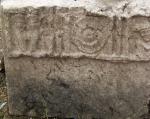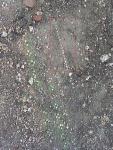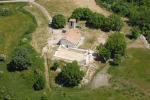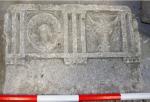Summary (English)
During cleaning work undertaken in 2005, the remains of an opus signinum floor was uncovered in the area east of the church. The floor was decorated with mosaic tessera forming a geometric motif of regular dots on a ground of small white tessera, of about 1 cm, alternating with a small cross motif of black tesserae, with one central tesserae surrounded by three others of the same size. (fig. 2). The floor dated to the Republican-late republican period.
Surveys undertaken around the Church have recovered fragments of black glaze pottery, including several examples of Morel type 2760, dating to the 2nd century B.C. Sigillata Italic and ARS were also collected, including a Hayes 8A (90 – mid 2nd century A.D.), Hayes 27 (second half of the 2nd – early 3rd century A.D.), Hayes 9B (second half of the 2nd century A.D.) and a Hayes 14A (Antonine period).
Among the numerous fragments of Roman and medieval coarse wares and cooking wares of different forms and sizes, two rims of large jars were identified, one with parallels in Campania, in contexts at Pompeii and Pontecagnano dating to the 1st century B.C. – 1st century A.D.
Two limestone blocks with Doric friezes from two different funerary monuments were found in the same area.The first (57 × 78 × 40 cm) was reused to cover a medieval tomb and is characterised by a Doric frieze alternating triglyphs and metopes decorated with a torus, a ‘spiral’ floral motif and a figure with a covered head (fig.3).
The other block (42 × 73 × 24 cm) is decorated with a Doric frieze alternating triglyphs and metopes decorated with a torus and a floral motif. This also seems to have been part of a funerary monument, in which it was probably a base or support (fig. 4). Both are of Republican date.A funerary inscription was reused at the top of the steps leading down into the crypt of the Benedictine monastery.
The quadrangular limestone block (1.37 × 0.83 × 0.36 cm; visible height 5 – 6 cm), has two holes in the upper left side indicating that it had once been part a large structure, probably a mausoleum (fig. 5).
The inscription reads:M(arcus) Popillio M(arci) f(ilius) Vol(tinia) Marcello
IIII Viro q(uinquennalis) sibi et
M(arcus) Popillio C. f(ilius) Nicro patri
Vibiae Q(uintae) l(ibertae) Quintae matri
Liciniae C(aiae) l(ibertae) Faustae uxori
heredes ex testamento
- Angela Di Niro - Soprintendenza per i Beni Archeologici del Molise
- Isabella Muccilli
Director
- Valeria Ceglia - Soprintendenza per i Beni Archeologici del Molise
Team
Research Body
- Soprintendenza per i Beni Archeologici del Molise
Funding Body
- Comune di Mirabello Sannitico






![Download [PDF]](/excavation/skins/fasti/images/results/download_sml.png)



